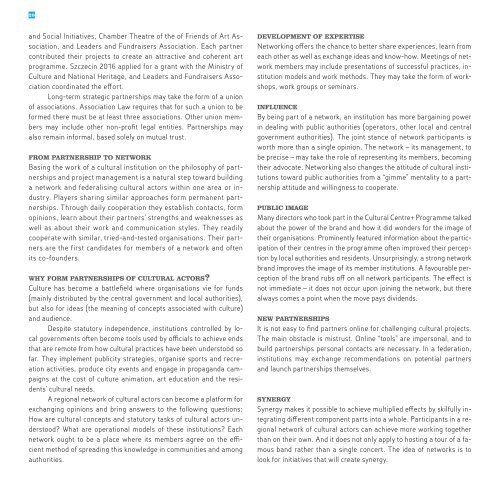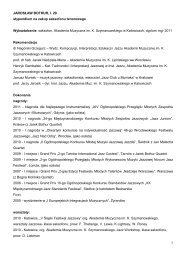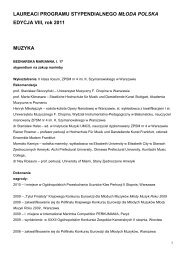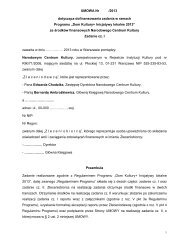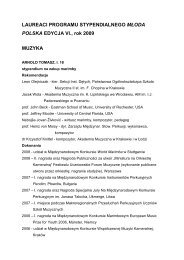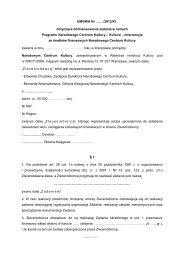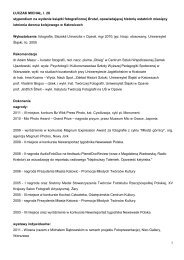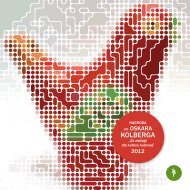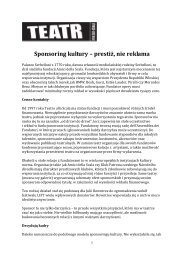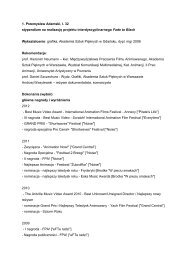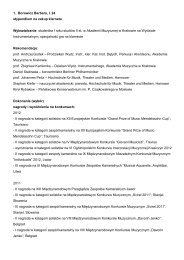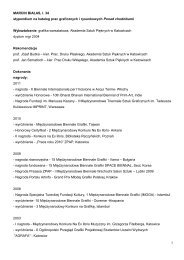Untitled - Narodowe Centrum Kultury
Untitled - Narodowe Centrum Kultury
Untitled - Narodowe Centrum Kultury
Create successful ePaper yourself
Turn your PDF publications into a flip-book with our unique Google optimized e-Paper software.
28<br />
and Social Initiatives, Chamber Theatre of the of Friends of Art Association,<br />
and Leaders and Fundraisers Association. Each partner<br />
contributed their projects to create an attractive and coherent art<br />
programme. Szczecin 2016 applied for a grant with the Ministry of<br />
Culture and National Heritage, and Leaders and Fundraisers Association<br />
coordinated the effort.<br />
Long-term strategic partnerships may take the form of a union<br />
of associations. Association Law requires that for such a union to be<br />
formed there must be at least three associations. Other union members<br />
may include other non-profit legal entities. Partnerships may<br />
also remain informal, based solely on mutual trust.<br />
from partnership to network<br />
Basing the work of a cultural institution on the philosophy of partnerships<br />
and project management is a natural step toward building<br />
a network and federalising cultural actors within one area or industry.<br />
Players sharing similar approaches form permanent partnerships.<br />
Through daily cooperation they establish contacts, form<br />
opinions, learn about their partners’ strengths and weaknesses as<br />
well as about their work and communication styles. They readily<br />
cooperate with similar, tried-and-tested organisations. Their partners<br />
are the first candidates for members of a network and often<br />
its co-founders.<br />
why form partnerships of cultural actors<br />
Culture has become a battlefield where organisations vie for funds<br />
(mainly distributed by the central government and local authorities),<br />
but also for ideas (the meaning of concepts associated with culture)<br />
and audience.<br />
Despite statutory independence, institutions controlled by local<br />
governments often become tools used by officials to achieve ends<br />
that are remote from how cultural practices have been understood so<br />
far. They implement publicity strategies, organise sports and recreation<br />
activities, produce city events and engage in propaganda campaigns<br />
at the cost of culture animation, art education and the residents’<br />
cultural needs.<br />
A regional network of cultural actors can become a platform for<br />
exchanging opinions and bring answers to the following questions:<br />
How are cultural concepts and statutory tasks of cultural actors understood<br />
What are operational models of these institutions Each<br />
network ought to be a place where its members agree on the efficient<br />
method of spreading this knowledge in communities and among<br />
authorities.<br />
development of expertise<br />
Networking offers the chance to better share experiences, learn from<br />
each other as well as exchange ideas and know-how. Meetings of network<br />
members may include presentations of successful practices, institution<br />
models and work methods. They may take the form of workshops,<br />
work groups or seminars.<br />
influence<br />
By being part of a network, an institution has more bargaining power<br />
in dealing with public authorities (operators, other local and central<br />
government authorities). The joint stance of network participants is<br />
worth more than a single opinion. The network – its management, to<br />
be precise – may take the role of representing its members, becoming<br />
their advocate. Networking also changes the attitude of cultural institutions<br />
toward public authorities from a “gimme” mentality to a partnership<br />
attitude and willingness to cooperate.<br />
public image<br />
Many directors who took part in the Cultural Centre+ Programme talked<br />
about the power of the brand and how it did wonders for the image of<br />
their organisations. Prominently featured information about the participation<br />
of their centres in the programme often improved their perception<br />
by local authorities and residents. Unsurprisingly, a strong network<br />
brand improves the image of its member institutions. A favourable perception<br />
of the brand rubs off on all network participants. The effect is<br />
not immediate – it does not occur upon joining the network, but there<br />
always comes a point when the move pays dividends.<br />
new partnerships<br />
It is not easy to find partners online for challenging cultural projects.<br />
The main obstacle is mistrust. Online “tools” are impersonal, and to<br />
build partnerships personal contacts are necessary. In a federation,<br />
institutions may exchange recommendations on potential partners<br />
and launch partnerships themselves.<br />
synergy<br />
Synergy makes it possible to achieve multiplied effects by skilfully integrating<br />
different component parts into a whole. Participants in a regional<br />
network of cultural actors can achieve more working together<br />
than on their own. And it does not only apply to hosting a tour of a famous<br />
band rather than a single concert. The idea of networks is to<br />
look for initiatives that will create synergy.


